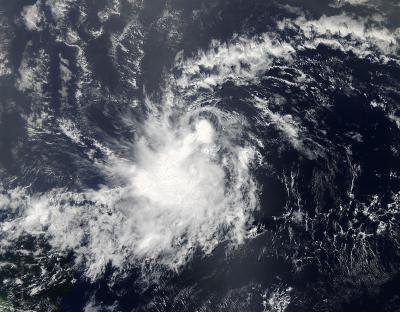The third tropical cyclone of the Atlantic Ocean season developed in the Atlantic and not in the Gulf of Mexico as the previous two systems,Tropical Storm Chantal.The Moderate Resolution Imaging Spectroradiometer (MODIS) instrument that flies aboard NASA's Aqua satellite captured a visible image of Tropical Storm Chantal on July 7 at 12:15 p.m. EDT when it was located off the coast of Brazil. The highest and strongest thunderstorms (that cast shadows on the surrounding lower storms) were around the center of circulation.
On Monday, July 8, Chantal was nearing land areas and warnings and watches were posted. A Tropical Storm Warning is in effect for Barbado, Dominica, Saint Lucia, Martinique, and Guadeloupe, and a Tropical Storm Watch is in effect for Saint Vincent.
In the warning area by early Tuesday, July 9, the National Hurricane Center or NHC expects tropical storm conditions. Those conditions are expected in the watch area later on July 9. Chantal is expected to bring the Leeward and Windward islands rainfall between 2 and 4 inches, with isolated totals to 6 inches.

The MODIS instrument aboard NASA's Aqua satellite captured a visible image of Tropical Storm Chantal on July 7 at 12:15 p.m. EDT when it was located off the coast of Brazil.
(Photo Credit: NASA Goddard MODIS Rapid Response)
At 8 a.m. EDT (1200 UTC) Chantal's maximum sustained winds were near 40 mph (65 kph) and are expected to increase. The center of Tropical Storm Chantal was located near latitude 10.6 north and longitude 50.6 west. The estimated minimum central pressure is 1007 millibars. The NHC reported that Chantal is moving toward the west near 26 mph (43 kph) and a west-northwestward motion at about the same forward speed is expected over the next couple of days.
Chantal developed from an unseasonally strong easterly wave that moved off the African coast on July 3, according to Brian McNoldy, Senior Research Associate at University of Miami's Rosenstiel School of Marine and Atmospheric Science.
After affecting the Lesser Antilles Tuesday, Chantal is expected to move into the eastern Caribbean Sea.
Source: NASA/Goddard Space Flight Center